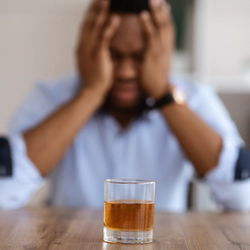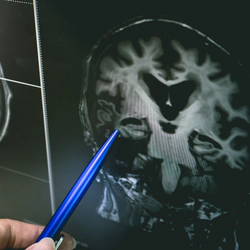Even One Alcoholic Beverage is Harmful to Your Brain
Recent findings show no “safe” level of drinking, and any amount of alcohol consumption carries with it a potentially long-term harmful effect.

New research challenges the archaic narrative that so-called “moderate” drinking does not harm the human body. The study authors posit that even light-to-moderate drinking is associated with harm to the brain. How did the authors come to this conclusion? The researchers analyzed data from more than 36,000 adults. In so doing, they found a link between drinking and reduced brain volume, which begins at an average consumption level of less than one alcohol unit daily, the equivalent of about half a beer. Further, the risk rises exponentially with each additional drink consumed.
What the Findings Show
“More alcohol, less brain: Association begins with an average of just one drink a day.” That is the headline of a groundbreaking study by the University of Pennsylvania published in Nature Communications on March 4th, 2022. The thesis of the study is simple enough, even light-to-moderate drinking is associated with harm to the brain. The researchers found that alcohol consumption as limited as drinking half a beer was associated with negative impacts on the drinker’s brain.1
After studying more than 36,000 adults, the researchers found that when people who drank went from one to two drinks per day, they suffered cognitive changes in the brain equivalent to aging two years. Going from two drinks to three was like aging the brain three and a half years. Logically, heavier drinking was associated with an even greater toll. The more alcohol adults in the study drank, the more apparent and pronounced their cognitive decline was.

While the physical and psychological harm of heavy drinking has always been known, the details of the University of Pennsylvania’s research about cognitive harm connected to light drinking are truly groundbreaking. Dr. Gideon Nave, a corresponding author on the study and faculty member at Penn’s Wharton School, highlighted how, because of the study’s large sample size, the researchers could determine that even very light drinking shrinks the brain and ages it prematurely. “The fact that we have such a large sample size allows us to find subtle patterns, even between drinking the equivalent of half a beer and one beer a day.” While one-half of one beer per day did not have as pronounced an effect as 2-3 beers per day, there was still a noticeable, tangible effect on brain size and cognitive function.
Critically, the study shows how the nation’s leading health institutions need to revise their recommendations regarding alcohol consumption. Dr. Henry Kranzler, another study author, spoke to this point. “These findings contrast with scientific and governmental guidelines on safe drinking limits. For example, although the National Institute on Alcohol Abuse and Alcoholism recommends that women consume an average of no more than one drink per day, recommended limits for men are twice that, an amount that exceeds the consumption level associated in the study with decreased brain volume.” The National Institute on Alcohol Abuse and Alcoholism and the National Institute on Drug Abuse must change their guidelines to reflect that ANY alcohol consumption poses risks to brain health.2
How Alcohol “Ages” the Brain
But how is alcohol affecting the brain? Previous studies showed mixed results. While it’s always been known that heavy drinking is correlated with strong reductions in gray and white matter across the brain, past studies have shown mixed results regarding moderate and light drinking and the brain. The study published in Nature Communications is the first of its kind. It uses a large enough dataset that the researchers could closely examine how moderate and light drinking affected the brain. “Having this dataset is like having a microscope or a telescope with a more powerful lens, said Dr. Gideon Nave, one of the study authors and a faculty member at Penn’s Wharton School. “You get a better resolution and start seeing patterns and associations you couldn’t before.”
The researchers were able to control for confounding variables that would have otherwise clouded the relationship between light drinking and brain health. For example, they controlled for age, height, sex, smoking status, socioeconomic status, genetic ancestry, county of residence, and head size.
Next, the researchers examined surveys of 36,000 adults in which respondents answered questions about their alcohol consumption. When the researchers compared the responses with examinations of respondents’ brain health, a pattern emerged.

The pattern was as follows: The gray and white matter volume within the brain that might otherwise be normal and healthy was reduced somewhat in people who responded “yes” to questions about alcohol consumption, even if those individuals drank very little alcohol.
Gray and white brain matter reduces as one ages, so a good way to show how drinking affects the brain is to relate alcohol consumption to “aging the brain prematurely.”
When the findings were viewed through the lens of prematurely aging the brain, the analysis was shocking:
-
People who drank one-half to one drink per day had brains that tested as being about six months to one year “older” than they should have been, as measured by how much white and gray matter was in those brains and how much should have been in those brains, given the individuals’ age.
-
People who had two drinks daily suffered gray matter loss in their brains equivalent to aging two years.
-
Three drinks per day left people with a brain that had the characteristics of a brain three and a half years older than the individual.
-
Most alarmingly, people who drank four drinks per day had brains so affected by alcohol that those brains contained the gray and white matter of a brain ten years older than the individual.
The Toll of Alcohol
Every year, at least 14.5 million Americans struggle with alcohol addiction, and about 140,000 die from alcohol-related causes. The National Institute on Alcohol Abuse and Alcoholism (NIAAA) reports fewer than 10% of those who struggle with alcohol addiction ever receive treatment for it, and alcohol misuse ends up costing the United States about $249 billion each year. At least 9,000 people in the U.S. die in drunk driving accidents every year, and about one in ten U.S. children grow up in homes where at least one parent misuses alcohol. Further, alcohol consumption adversely affects one’s physical health, including harming their heart, liver, breasts, throat, colon, immune system, and pancreas.3
These are the painfully obvious, very clear harms connected to alcohol abuse. And while some people may think that losing gray and white matter in the brain might not sound like too high a cost to pay to be able to “enjoy” alcohol from time to time, everyone who is addicted to alcohol and who is likely suffering from the above problems as reported by NIAAA is someone who started by just consuming one or two drinks per day, or a drink every other day. If the loss of gay and white matter in the brain from drinking 1-2 drinks per day is not enough to dissuade someone from drinking, the fact that 1-2 drinks per day sets the stage for potential alcohol abuse and addiction should be.
People Should Reduce Alcohol Consumption to Zero to Preserve Their Health
There can no longer be any mystery that alcohol is harmful, even when consumed in low quantities. People who drink socially or casually should reduce their consumption to zero or, at the very least, consume as little alcohol as possible. For those who consume alcohol and who cannot stop consuming it, they must seek help at a qualified residential alcohol treatment center.
Sources Cited:
-
N.C. “Associations between alcohol consumption and gray and white matter volumes in the U.K. Biobank.” Nature Communications, 2022. nature.com ↩︎
-
ScienceDaily. “More alcohol, less brain: Association begins with an average of just one drink a day.” Science Daily, 2022. sciencedaily.com ↩︎
-
NIAAA. “Alcohol Facts and Statistics.” National Institute on Alcohol Abuse and Alcoholism, 2022. niaaa.nih.gov ↩︎





 ®
®